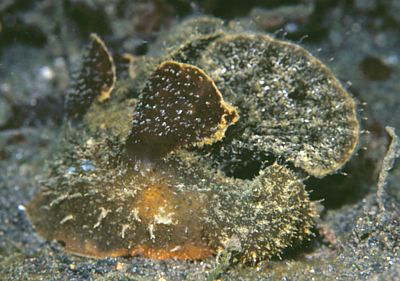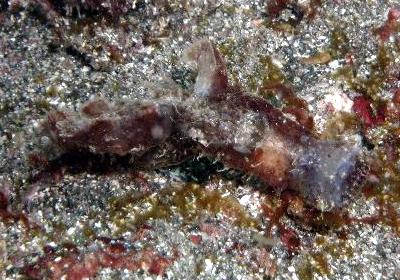Melibe spp
Unidentified species, Natural History, etc.
Order: NUDIBRANCHIA
Suborder: DENDRONOTINA
Family: Tethydidae
Rudman, W.B., 2000 (October 16) Melibe spp Unidentified species, Natural History, etc.. [In] Sea Slug Forum. Australian Museum, Sydney. Available from http://www.seaslugforum.net/find/melibespp
Related messages
Non-swimming species of Melibe
February 26, 2003
From: Thierry Thibaut
Hi,
To answer Paul Katz's question about a non-swimming Melibe species. I saw a video made by my friend Ante Zuljevic (Institute of Fisheries of Split, Croatia) showing a big specimen of Melibe fimbriata crawling on a Caulerpa taxifolia meadow in the Adriatic Sea. During all the film, the species never swam.
Thierry
thibaut@ceab.csic.es
Thanks Thibaut,
I have put messages referring to Melibe fimbriata on the Melibe viridis page because I can't find any easy way to distinguish the two species. There is a message from Peter van Bragt with photos of swimming Melibe fimbriata from Turkey. Also Thompson & Crampton (1984), when they first reported this species from Turkey, described its swimming in some detail. Many of these swimming nudibranchs seem quite reluctant to use their swimming abilities, but when they start they often continue for a considerable period of time.
Thompson & Crampton's paper reminded me of the South African species, Melibe rosea, which like the southern Australian species, M. australis, does not swim. Melibe rosea, which grows to 50mm, might be a better comparative species than M. australis, which seldom grows larger than 10mm. By coincidence, neither species is at present represented on the Forum. Hopefully that gap will be filled in the near future.
• Thompson, T.E., Crampton, D.M. (1984) Biology of Melibe fimbriata, a conspicuous opisthobranch mollusc of the Indian Ocean, which has now invaded the Mediterranean Sea. Journal of Molluscan Studies, 50(2): 113-121.
Best wishes,
Bill Rudman
Non-swimming Melibe
February 12, 2003
From: Paul Katz
Hi,
Does anyone know if there is a species of Melibe that does not swim or has not been observed to swim? I'm interested in doing a comparative study with Melibe leonina. Melibe mirifica looks large enough and benthic enough that it might not swim. Any thoughts?
Paul Katz
pkatz@gsu.edu
Dear Paul,
The only one I can think of that I don't think swims is the tiny Australian species Melibe australis. I soon as I get a chance to scan some photos I will prepare a page on the species.
Best wishes,
Bill Rudman
Melibe from Sulawesi
December 22, 2002
From: Mary Jane Adams


Hi Bill,
This Melibe was resting on a silty black sand slope in Lembeh Strait, Sulawesi Island, Indonesia. It was about 15-20cm long and about 15 meters deep.
Divesite: JAHIR November 21, 2002.
Can you ID it?
Thanks,
Mary Jane
divepng@yahoo.com
Adams, MJ., 2002 (Dec 22) Melibe from Sulawesi. [Message in] Sea Slug Forum. Australian Museum, Sydney. Available from http://www.seaslugforum.net/find/8656Dear Mary Jane,
The very broad, unbranched ends [I hesitate to call them tips] to the cerata in this species are quite different from what I would identify as Melibe viridis, so until I can hunt down a description that fits this shape I will put your species on the Melibe spp Page.
Cheers,
Bill Rudman
Further information on the Melibe
October 26, 2000
From: Nishina Masayoshi
Dear Dr. Rudman
I hear that this type and color of Melibe is quite common at Hachijo Island area. That Melibe's length is around 4cm to 5cm.
I found it at 8m to 10m depth. And one remarkable thing is that it wiggled strongly
when it moved or swam after a guide picked up it.
Nishina Masayoshi
nishina@hpe15.wips.co.jp
Masayoshi, N., 2000 (Oct 26) Further information on the Melibe. [Message in] Sea Slug Forum. Australian Museum, Sydney. Available from http://www.seaslugforum.net/find/3208Dear Nashina,
I think we still have quite a bit to learn about this genus. Unfortunately two characters we use a lot in nudibranch taxonomy, the colour and shape of the radular teeth aren't available in Melibe because they do not have a radula and their colour is quite variable. It also seems the juveniles may look quite different from adults. Terry Gosliner (1987) has given us an excellent summary of our knowledge of the group.
What I think we need now is some studies of populations in a particular geographic areas so we can get a better idea of the variation in shape between juveniles and adults and the variation in colour, shape of cerata, and degree of papillation, within a population. Without that knowledge it is very difficult to decide how many species there are.
For example Baba (1949) identified a species from Japan as Melibe papillosa de Filippi, 1867 but Odhner (1936) and Gosliner(1987) consider that this is a synonym of M. pilosa Pease, 1860. We can't really resolve many of the problems because the original descriptions were not detailed enough, and we don't know how variable the various characters are. One very useful clue could be adult size. You mention your animal animal only grows to 4 or 5 cms. If this its limit then it is unlikely to be the same as a species which c an grow to three or four times that length.
Your mention of its swimming motion is also interesting. There are quite a few observations of species of Melibe swimming. By flattening their cerata and their oral veil vertically, they can swim quite effectively through the lateral flexion of their body. A fairly clumsy, but quite effective way to escape from a non=swimming predator. A related animal Bornella anguilla uses this method to swim, and does it so effectively that it has been given the name 'anguilla' which is from a Latin word for an eel.
Best wishes,
Bill Rudman.
Melibe sp. from Japan
October 18, 2000
From: Nishina Masayoshi

Dear Dr.Rudman,
This is Nishina, I've been to Hachijo Island
in Japan at last weekend [Oct 2000]. I found a Melibe. This was the first time I have seen it with my own eyes. I like it very much though it's not colorful.
Nishina
nishina@hpe15.wips.co.jp
Masayoshi, N., 2000 (Oct 18) Melibe sp. from Japan. [Message in] Sea Slug Forum. Australian Museum, Sydney. Available from http://www.seaslugforum.net/find/3136Dear Nishina,
As you say, the species of Melibeare not very colourful, but despite that they are very fascinating to watch. The way they move along, using their oral hood to feel for little crustaceans to eat, almost makes them seem to have an intelligence.
I am afraid I can't see enough of the animal to be sure of its identity, although it is one of the species with many papillae on the body. Could you give me some idea of how long it was alive? Perhaps Terry Gosliner can give us his opinion.
Best wishes,
Bill Rudman.
